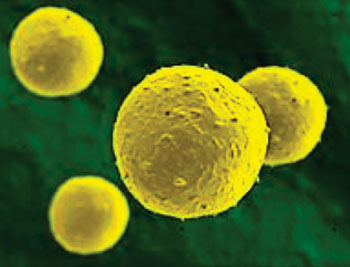New Test Could Revolutionize Cancer Diagnosis
By LabMedica International staff writers
Posted on 21 Sep 2016
A new blood test has been developed that could detect cancer earlier than ever before and it will change the way cancer is diagnosed, and in turn potentially save millions of lives.Posted on 21 Sep 2016
The assay is based on a simple blood test and it could be used to identify cancer in undiagnosed patients. It would be used to screen people who are at-risk or are asymptomatic, meaning it could detect cancer even before symptoms begin to show.

Image: A colorized scanning electron micrograph (SEM) of esophageal cancer cells (Photo courtesy of the University of California-Davis).
Scientists at Swansea University Medical School (UK) have optimized this test over the past four years in more than 300 individuals using esophageal cancer as an example. The studies included healthy controls, pre-cancer patients and patients with cancer. The blood is stained with antibodies, which work as markers to see if there have been changes to the surface. It takes around 30 minutes to test the blood, and they estimate each test costs around GBP 35 or USD 46. The test was able to distinguish healthy volunteers and patients with a pre-cancerous condition of the esophagus, from those with cancer itself.
In healthy control individuals, only a few mutated cells are detected per million red blood cells with a mean of about five per million, but in cancer patients this can rise by over 10-fold to 50-100 mutants per million. In patients undergoing chemotherapy, who are exposed to drugs that deliberately induce DNA mutations, the levels can be several hundred per million. Interestingly, these red blood cell mutations do not play a direct role in the cancer development process. They are “collateral damage” produced in circulating blood cells as a by-product of a cancer developing internally. The benefit of the blood cell mutation is that it can be monitored in a simple, efficient, and non-invasive way. The actual test on the blood takes a few hours to perform in the laboratory and can be done in any standard pathology department, as it utilizes standard laboratory equipment.
Gareth Jenkins, PhD, a professor and lead investigator, said, “The test detects changes, known as mutations, in red blood cell surface proteins. These sugary proteins act as “Velcro” to stick cell recognition proteins to the cell surface. In mutated cells, the “Velcro” is missing and so the cells are “naked” for the protein of interest. Staining cells with fluorescent antibodies for the cell recognition proteins identifies normal from mutated cells which allows a mutant cell frequency to be calculated per person.” The study was presented on September 6, 2016, at the British Science Festival held at Swansea University, UK.
Related Links:
Swansea University Medical School









 Analyzer.jpg)



